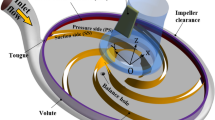Abstract
The energy recovery and utilization of high-pressure brine are the key to reduce the cost. Reducing flow rate method (RFM) was put forward firstly to adapt pump as turbine (PAT) to a wide range of operating conditions in this paper. In order to validate advantages of the new method, three different designs of PAT were obtained, respectively, based on three different methods, which were, respectively, selection design method, forward curved method and RFM. Based on numerical method, the external energy characteristics, axial force and internal flow patterns of PATs were analyzed. Results show that matching of the blade inlet angle and flow angle at the blade leading edge has a great influence on the turbine flow patterns which are directly related to the efficiency of PAT. A PAT designed by the new design method RFM improves both the hydraulic efficiency and shaft power under design and partial load conditions. Moreover, the axial force of the PAT designed by RFM is reduced, which can improve the reliability of the PAT operation with high rotating speed.



















Similar content being viewed by others
Abbreviations
- BEP:
-
Best efficiency point
- CFD:
-
Computational fluid dynamics
- PAT:
-
Pump as Turbine
- RO:
-
Reverse osmosis membrane
- SDM:
-
Selection design method
- FCM:
-
Forward curved method
- RFM:
-
Reducing flow rate method
References
Saifaoui D, Nachtane M, Tarfaoui M et al (2020) Heat recovery from sulfuric acid plants for seawater desalination using RO and MED systems. Applied Water Science 10(4):1–10
Carravetta A, Fecarotta O, Sinagra M et al (2013) Cost-benefit analysis for hydropower production in water distribution networks by a pump as turbine[J]. J Water Resour Plan Manag 140(6):04014002
Pugliese F, Paola FD, Fontana N et al (2016) Experimental characterization of two Pumps as Turbines for hydropower generation. Renew Energy 99:180–187
Barbarelli S, Amelio M, Florio G (2016) Predictive model estimating the performances of centrifugal pumps used as turbines. Energy 107:103–121
Doshi A, Channiwala S, Singh P (2017) Inlet impeller rounding in pumps as turbines: an experimental study to investigate the relative effects of blade and shroud rounding. Exp Thermal Fluid Sci 82:333–348
Mansour TM, Ismail TM, Ramzy K, Abd El-Salam M (2020) Energy recovery system in small reverse osmosis desalination plant: experimental and theoretical investigations. Alex Eng J 59:3741–3753
Jiafan L (1997) Characteristic analysis of pump turbine operation. J Agric Mach 28(3):20–24
Xiandao S (1989) Experimental study on the third quadrant performance of vane pump. Pump Technol 1:51–54
Sunsheng Y, Derakshan S, Fanyu K (2012) Theoretical, numerical and experimental prediction of pump as turbine performance. Renew Energy 48:507–513
Sharma K (1985) Small hydroelertric project-use of centrefugal pumps as turbines. Kirloskar Electric Co, Bangalore, India
Stepanoff AJ (1957) Centrifugal and axial folw pumps. John Wiley, New York
Singh P, Nestmann F (2010) An optimization routine on a prediction and selection model for the turbine operation on a prediction and selection model for the turbine operation of centrifugal pumps[J]. Exp Thermal Fluid Sci 34(2):152–164
Singh P, Nestmann F (2011) Internal hydraulic analysis of impeller rounding in centrifugal pumps as turbines[J]. Exp Thermal Fluid Sci 35(1):121–134
Shuren S (1984) Study on the utilization of pump reversal and turbine energy recovery. Fluid Mach 6:41–45
Tao W, Fanyu K, Yingying L, Qineng W (2017) Numerical simulation and verification of the influence of blade inlet angle on the external characteristics of pump turbine. J Agric Eng 33(15):98–104
Štefan David, Rossi Mosè, Hudec Martin, Rudolf Pavel, Nigro Alessandra, Renzi Massimiliano (2020) Study of the internal flow field in a pump-as-turbine (PAT): Numerical investigation, overall performance prediction model and velocity vector analysis. Renew Energy 156:158–172
Rossi M, Renzi M (2017) Analytical prediction models for evaluating Pumpsas-Turbines (PaTs) performance. Energy Procedia 118:238–242. https://doi.org/10.1016/j.egypro.2017.07.011
Fontanella Stefania, Fecarotta Oreste, Molino Bruno, Cozzolino Luca, Morte Renata Della (2020) A performance prediction model for Pumps as Turbines (PATs). Water 12(4):1175
Asomani Stephen Ntiri, Yuan Jianping, Wang Longyan et al (2020) The impact of surrogate models on the multi- objective optimization of Pump-As-Turbine (PAT). Energies 13(9):2271
Shouqi Y, Weidong S, Houlin L et al (2014) Pump theory and technology. China Machine Press, Beijing
Geng L, Escaler X (2020) Assessment of RANS turbulence models and Zwart cavitation model empirical coefficients for the simulation of unsteady cloud cavitation. Eng Appl Comput Fluid Mech 14(1):151–167
Long Y, Long X, Ji B et al (2017) Verification and validation of URANS simulations of the turbulent cavitating flow around the hydrofoil. J Hydrodyn 29(4):610–620
Menter FR, Kuntz M, Langtry R (2003) Ten years of industrial experience with the SST turbulence model. Turbul Heat Mass Transf 4:625–632
Spalart PR (2009) Detached-eddy simulation. Annu Rev Fluid Mech 41:181–202
Menter FR (1993) Zonal two equation k-ω turbulence models for aerodynamic flows. AIAA Paper 2906
Guan XingFan (2011) Modern pumps theory and design. China Aerospace Press, Bei Jing
Acknowledgements
This study is financially supported by the National key R&D project (2017YFC0404201) and Key R & D projects in Jiangsu Province (BE2017144). The supports are gratefully acknowledged.
Author information
Authors and Affiliations
Corresponding author
Additional information
Technical Editor: Monica Carvalho.
Publisher's Note
Springer Nature remains neutral with regard to jurisdictional claims in published maps and institutional affiliations.
Rights and permissions
About this article
Cite this article
Qi, B., Zhang, D., Li, Y. et al. A comparative study on the reducing flow rate design method for a desalination energy recovery pump as turbine. J Braz. Soc. Mech. Sci. Eng. 43, 441 (2021). https://doi.org/10.1007/s40430-021-03143-w
Received:
Accepted:
Published:
DOI: https://doi.org/10.1007/s40430-021-03143-w




